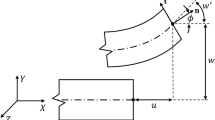Abstract
The creep line-spring method proposed in this paper is based on the solutions for the following two problems: a creep crack under non-steady creep condition; an elastic-plastic surface-cracked plate. For the problem of a non-steady creep crack, an engineering approach for estimating the load-line displacement, crack-tip J and C integrals is presented by extending the engineering approach for elastic-plastic fracture analysis to creep analysis. For solving the elastic-plastic surface crack, a simplified elastic-plastic line-spring method is applied. These two approximate solutions are checked by the finite element method. On the basis of the above two approximate methods, a creep line-spring method is proposed and the corresponding fundamental equations are established. The creep line-spring method is used to estimate creep fracture parameters for three-dimensional cracks. In order to check its accuracy, several surface-cracked plates under uniform tension are analyzed by the creep line-spring method and by the three-dimensional finite-element method. The numerical results show that the creep line-spring method is in good agreement with the finite-element method and has the same accuracy as the common elastic-plastic line-spring method.
Similar content being viewed by others
References
ABAQUS user' manual (1994). Version 5.4, Hibbitt, Karlsson and Sorensen, Inc., Providence, Rhode Island.
Ainsworth, R.A. and Budden, P.J. (1990). Crack tip fields under non-steady creep conditions. I. Estimates of the Amplitudes of the Fields. Fatigue and Fracture of Engineering Materials and Structures 13 (3), 263–276.
Bassini, J.L. and McClintock, F.A. (1981). Creep relaxation of stress around a crack tip. International Journal of Solids and Structures 17, 479–492.
Chai Guozhong and Zhang shujia. (1998). The analysis of C.t/ and J.t/ integrals for non-steady creep crack by finite element method. Journal of Zhejiang University of Technology, China 26 (3), 177–183.
Ehlers, R. and Riedel, H. (1981). A Finite Element Analysis of Creep Deformation in a Specimen Containing a Macroscopic Crack. In: Advances in Fracture Research, ICF-5 (Edited by D. Franç ois) Cannes, France, 691–698.
Joseph, P.F and Erdogan, F. (1989). Surface crack problems in plates. International Journal of Fracture 41, 105–131.
Kumar, V., German, M.D. and Shih, C.F. (1981).An Engineering Approach for Elastic-Plastic Fracture Analysis, EPRI Topical Report NP-1931, Research Project 1237- 1.
Landes, J.D and Begley, J.A. (1976). A Fracture Mechanics Approach to Creep Crack Growth, ASTM STP590, 128–148.
Miyoshi, T., Shiratori, M. and Yoshida, Y. (1986). Analysis of J-integral and crack growth for surface cracks by line spring method. Journal of Pressure Vessel Technology, ASME 108, 305–311.
Nikbin, K.M., Smith, D.J. and Webster, G.A. (1986). An engineering approach to the prediction of creep crack growth. Journal of Engineering Materials and Technology 108, 186–191.
Parks, D.M. (1981). The inelastic line-spring: estimates of elastic-plastic fracture mechanics parameters for surface-cracked plates and shells. Journal of Pressure Vessel Technology, ASME 103, 246–254.
Rice, J.R. and Levi, N. (1972). The part-through surface crack in an elastic plate. Journal of Applied Mechanics ASME 39, 185–194.
Riedel, H. and Rice, J.R. (1980). Tensile Cracks in Creeping Solids, ASTM STP700, 112–130.
Shawki, T.G., Nakamura, T. and Parks, D.M. (1989). Line-spring analysis of surface flawed plates and shells using deformation theory. International Journal of Fracture 41, 23–38.
Shih, C.F and Needleman, A. (1984). Fully plastic crack problems. Journal of Applied Mechanics, ASME 51, 48–64.
Smith, S.D., Webster, J.J. and Hyde, T.H. (1988a). Creep behaviour of a stationary, semi-circular surface crack. Engineering Fracture Mechanics 30 (1), 105–116.
Smith, S.D., Webster, J.J. and Hyde, T.H. (1988b). Finite element simulation of elastic-creep growth of a semicircular surface crack. Engineering Fracture Mechanics 31 (6), 947–957.
Wang Yong. (1996). The Studies of Numerical Method for Fracture Analysis of Three-Dimensional Cracks., PhD Thesis. Zhejiang University of Technology, China.
Wang Zhengdong and Wu Dongdi. (1991). A damage mechanics approach to the prediction of creep crack growth. International Journal of Pressure Vessels and Piping 48, 305–319.
Author information
Authors and Affiliations
Rights and permissions
About this article
Cite this article
Guozhong, C., Shiratori, M. Creep analysis of surface-cracked plates by a creep line-spring method. International Journal of Fracture 104, 329–348 (2000). https://doi.org/10.1023/A:1007689122641
Issue Date:
DOI: https://doi.org/10.1023/A:1007689122641



